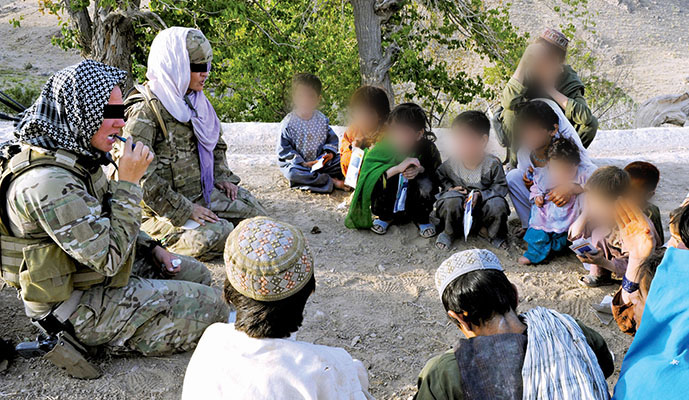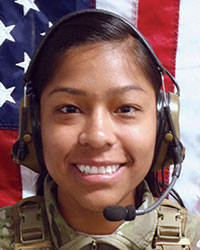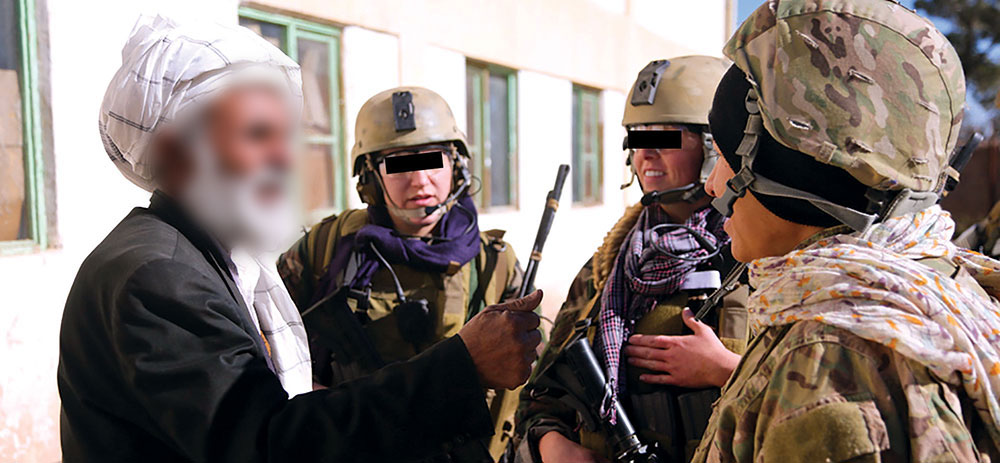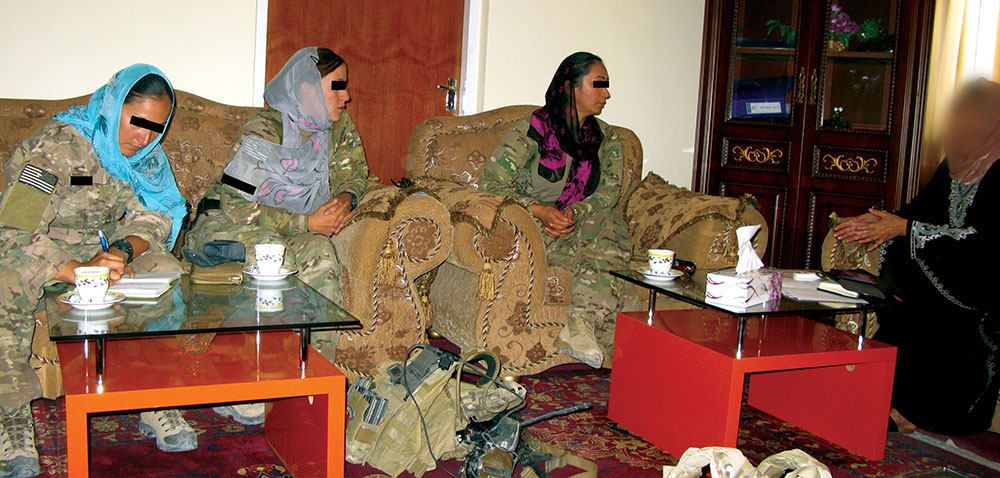From Veritas, Vol. 12, No. 2, 2016
TAKEAWAYS
- The USASOC CST program was created as a temporary, mission-driven enabler program directed at engaging Afghan women and children. It was not intended as a model for women in combat.
- USAJFKSWCS created a viable CST training program ‘out of hide’ to meet overseas mission requirements while sustaining existing training. A&S and the CSTC were critical to selecting and training the best candidates to serve on CSTs. However, the quick out-processing of CST females after re-deployment did not include a formal After Action Review or debriefing. This delayed course improvements.
- From PMT to deployment, CSTs had to continually ‘sell’ their capabilities to their supported SOF units because they were frequently attached to new teams unfamiliar with the program.
- CSTs provided valuable support to the DA and VSO missions in Afghanistan. They demonstrated ‘value-added’ by building rapport with the Afghan women and children; gathering useful information about high value targets and weapons caches; and promoting Afghan government legitimacy to the population.
- CST was an ad hoc concept, temporarily fielded with volunteers from the Total Army. Therefore, continuous, centralized administrative support for and accountability of CST soldiers from training through post-deployment was poor. If implemented again, a CST Program Manager or staff directorate should have authority to manage all CST personnel at the component level, regardless of their status—training or deployed.
- The concept of Cultural Support Teams as SOF enablers remains viable, provided that a mission requirement exists.
NOTE
*IAW USSOCOM Sanitization Protocol for Historical Articles on Classified Current Operations, pseudonyms are used for majors and below who are still on active duty, unless names have been publicly released for awards/decorations or DoD news release. Pseudonyms are identified with an asterisk. The eyes of personnel in photos are blocked out when not covered with dark visors or sunglasses, except when the photos were publicly released by a service or DoD. Source references (end notes) utilize the assigned pseudonym.
2009
August
Combined Joint Special Operations Task Force-Afghanistan (CJSOTF-A) briefs International Security Assistance Force (ISAF) and U.S. Central Command (USCENTCOM) about increasing U.S. female service member support to Special Operations Forces (SOF).3
2010
10 March
ISAF directs U.S. Forces, Afghanistan (USFOR-A) to develop a Cultural Support Team (CST) concept.4
25 May
U.S. Special Operations Command (USSOCOM) issues Tasking Order specifying five key CST tasks:
- Directly interacting with Afghan women and children
- Providing medical care for Afghan women and children
- Searching and questioning Afghan women and children
- Supporting information operations (IO) messaging to the female population and “minimiz[ing] civilian interference with military operations”
- Advising Special Operations Task Force commanders and small unit leaders on female aspects of Civil-Military Operations (CMO)
U.S. Army Special Operations Command (USASOC) directed to train Army CSTs.5
10 July
USCENTCOM drafts Request for Forces (RFF) for 64 females for CST missions in Afghanistan and Iraq (mission reduced to only Afghanistan before the first CST training class).7
26 July-25 August
The USASOC proponent for CST training, the U.S. Army John F. Kennedy Special Warfare Center and School (USAJFKSWCS), conducts three In-Progress Reviews (IPRs) to prepare for training. CST Program of Instruction (POI) is completed in September. Tentative start date for the first CST Assessment and Selection (A&S) is 1 November 2010, to be followed by the 6-week CST Training Course (CSTC), finishing around 15 December 2010.8
USSOCOM Rationale for the Term ‘Cultural Support Team’
Cultural: CSTs would respect Afghan culture by only using females to engage Afghan women and children. In addition, CSTs would receive training on Afghan history and culture.
Support: CSTs would support SOF units and missions as ‘attached’ rather than ‘assigned’ soldiers.
Teams: CSTs were to operate as two- or three-person teams.6
The CSTs Were:
- Combat Support enablers to Direct Action (DA) missions and Village Stability Operations (VSO).
- Specially assessed, selected, and trained for the mission.
The CSTs Were Not:
- Direct Action female assaulters.
- The main effort at VSO locations.
- The point element during combat and non-combat operations.2

8 September
USCENTCOM RFF 855 MOD 4 requests 20 females to support SOF.9
1 October
The 95th CA Brigade begins internal training program for CST applicants to help prepare them for A&S.10
1 November
The CST pilot program launched as 57 CST-1 candidates from USASOC and III Corps (Fort Hood, TX) units begin A&S at Camp Mackall, NC. 3rd Battalion, 1st Special Warfare Training Group (SWTG) has primary responsibility for all CST training, the active duty, reserve, or National Guard status of applicants notwithstanding.11
8 November
36 CST-1 selectees begin the first CSTC.12
10 November
USCENTCOM RFF 1210 requests 8 CSTs (24 personnel) to support SOF.13
10 December
31 soldiers of CST-1 graduate from the first CSTC.14
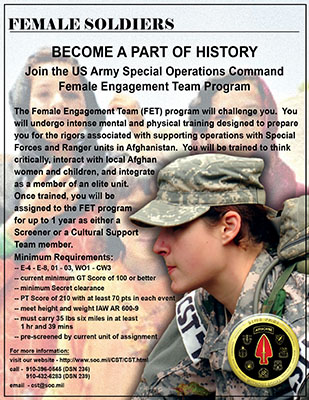
2011
January
After Pre-Mission Training (PMT) with SOF units, 28 personnel of CST-1 deploy to Afghanistan (11 support DA mission; 17 support VSO mission).16
1 March
Department of the Army approves Personnel Development Skill Identifier (PDSI) D5K (Cultural Support Team).19
17 March
A&S begins at Camp Mackall for Reserve Component and National Guard candidates of CST-2. 34 soldiers are soon selected.20 (Due to USASOC’s inability to meet demand for CSTs from its own units, applications were invited from across the total Army for CST-2.)
29 April
USAJFKSWCS assigned responsibility for the entire U.S. Army CST program.21
5 May
A&S held at Camp Mackall for Active Component candidates of CST-2. Selection ends on 13 May.22
6 June
Assessed and selected CST-2 soldiers begin the CSTC.23
19 July
56 soldiers of CST-2 graduate from the CSTC. A&S for CST-3 is scheduled for 12-16 September.24
27 July
USAJFKSWCS finalizes the Cultural Support Concept Plan to help transition the program “from only meeting RFF immediate needs to a capacity embedded [in Army Special Operations Forces (ARSOF)].”25
August
After PMT, 54 personnel from CST-2 deploy to Afghanistan (19 support DA mission; 35 support VSO mission).
August-September
CST-1 soldiers re-deploy from Afghanistan.28
22 October

CST-2 First Lieutenant (1LT) Ashley I. White, Medical Service Corps, 230th Brigade Support Battalion, 30th Heavy Brigade Combat Team, North Carolina Army National Guard, is killed in Kandahar Province, Afghanistan, while supporting 2/75th Ranger Regiment. She is the first CST killed in action.29
31 October
Assessed and selected CST-3 soldiers begin the CSTC.31
16 December
46 soldiers of CST-3 graduate from the CSTC.32




